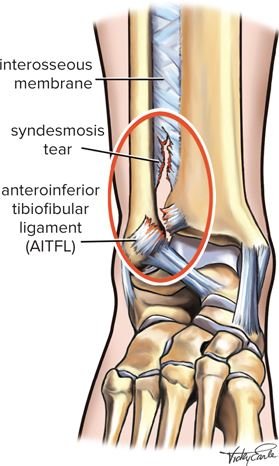What is a Syndesmosis Injury?
What is the syndesmosis?
The syndesmosis is a fibrous band connecting the two bones in the lower leg, known as the tibia and fibula. When there is separation of these two bones, the tibia and fibula, the injury is referred to as a syndesmosis.
Figure 1: Image courtesy of McGraw Hill Education (Australia). Illustration by Vicky Earle. From Brukner P, Khan K. Brukner & Khan’s Clinical Sports Medicine: Volume 1: Injuries. 5th ed. Sydney: McGraw Hill, 2017.
The syndesmosis includes the following:
Anterior-inferior tibiofibular ligaments (AITFL)
Posterior-inferior tibiofibular ligament (PITFL)
Interosseous membrane
Interosseous ligament (IOL)
Inferior transverse ligament (ITL)
The function of the syndesmosis is extremely important for the ankle:
1) It maintains integrity between the tibia and fibula (two shin bones)
2) Resists rotational forces (stabilises the ankle)
3) Allows motion of the ankle: dorsiflexion (pointing foot upwards) and plantarflexion (pointing foot downwards).
4) Stabilises the foot and ankle with walking/running
Figure 1: Image courtesy of McGraw Hill Education (Australia). Illustration by Vicky Earle. From Brukner P, Khan K. Brukner & Khan’s Clinical Sports Medicine: Volume 1: Injuries. 5th ed. Sydney: McGraw Hill, 2017.
What causes a syndesmosis injury?
High ankle Sprain and syndesmosis injuries are traumatic injuries that affect the distal tibiofibular ligaments and most commonly occur due to sudden external rotation of the ankle. This can occur when you plant your foot on the ground and twist your ankle, for example during a football game or rugby match.
What should you do if you suspect a syndesmosis injury?
If you think you have sustained a syndesmosis injury, then the first thing to do is rest and apply ice. Resting and reducing the swelling will help reduce pain and improve mobility. The use of crutches can also be useful to aid your recovery process, as they take pressure off your foot and ankle joint.
If pain persists for more than a few days or there is any swelling around the ankle joint, it's best to see a physiotherapist as soon as possible to determine whether further investigation (MRI) is required.
What are the signs and symptoms of a syndesmosis injury?
When you have a syndesmosis injury, you may experience several different symptoms:
Joint movement may be restricted and painful, particularly when attempting to move up onto their toes or side-to-side motion of their ankle may also be painful and limited.
Pain with weight-bearing and pressure of the area (particularly with stress or pressure) at the point where the bones are connected.
There may occasionally be a visible deformity at the site of injury, depending on whether there has been any displacement resulting from the injury. If there is a visible deformity at the site of injury, it will be because one or more structures have been completely ruptured. This situation is not common and can happen if there has been significant force applied to the area (for example, in a car accident).
Occasionally where there has been a complete rupture of one or two structures within or around the area, a clicking sensation may be felt in relation to certain movements or positions at this injured joint (or joints).
How is a syndesmosis injury diagnosed?
1) X-ray
May show an ankle fracture
Decreased overlap of the tibiofibular
2) CT:
If clinically suspected a CT may be ordered, however if there is no obvious fracture then a MRI if preferred due to the specificity of the scan and there’s no radiation.
3) MRI:
Ideal scan as it shows soft tissue and bone
Associated injuries:
Osteochondral defects
Fractures of the ankles (Webber B and C)
Ligament injuries including the deltoid ligament
What is the treatment of a syndesmosis injury?
The treatment for syndesmosis injury depends on whether surgery is needed to repair torn ligaments around your ankle joint.
Non-operative Treatment:
Cam-boot for 4-6 weeks with return to sport 8-12 weeks
Physiotherapy to improve strength and proprioception
Indications:
- Syndesmotic sprain without diastasis widening or ankle instability
Operative Treatment:
Screw or tightening rope
Indications:
- Syndesmotic sprain with instability on X-ray or CT scan
- Syndesmotic sprain with associated fracture that is unstable
Physiotherapy to improve strength and proprioception
See our expert Physiotherapy team at Frenchs Forest and Macquarie Park!
Figure 2: Ankle Pain - Syndesmosis Injuries - Physio Frenchs Forest, Physio Macquarie Park



